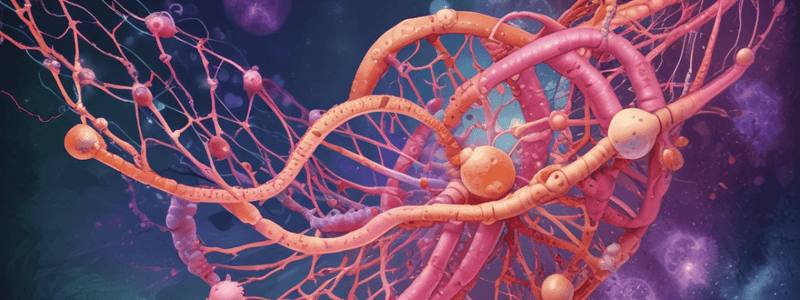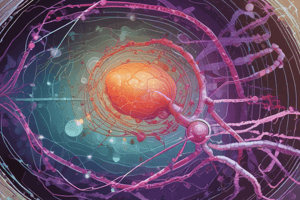Podcast
Questions and Answers
What is the primary function of tumor suppressor genes?
What is the primary function of tumor suppressor genes?
- To enhance cell migration and invasion
- To promote cell proliferation and growth
- To induce apoptosis in abnormal cells
- To inhibit cell growth and division (correct)
DNA repair mechanisms are only important for cancer cells.
DNA repair mechanisms are only important for cancer cells.
False (B)
Oncogenes are genes that normally inhibit cell growth and division.
Oncogenes are genes that normally inhibit cell growth and division.
False (B)
Match the following tumor suppressor genes with their associated types of cancer:
Match the following tumor suppressor genes with their associated types of cancer:
What is the result of the accumulation of mutations in a cell?
What is the result of the accumulation of mutations in a cell?
What is the role of oncogenes in normal cell growth and development?
What is the role of oncogenes in normal cell growth and development?
What is the result of genetic instability in cancer cells?
What is the result of genetic instability in cancer cells?
Cancer stem cells are thought to be responsible for the initiation and maintenance of tumors.
Cancer stem cells are thought to be responsible for the initiation and maintenance of tumors.
Tumor suppressor genes are normally involved in promoting cell growth and division.
Tumor suppressor genes are normally involved in promoting cell growth and division.
Explain the difference btw a proto-oncogene and an oncogene
Explain the difference btw a proto-oncogene and an oncogene
Why is DNA important for cells?
Why is DNA important for cells?
What 3 instructions does DNA provide for cells in terms of their function?
What 3 instructions does DNA provide for cells in terms of their function?
What are all cancers associated with?
What are all cancers associated with?
What happens within a cell that can initiate cancer
What happens within a cell that can initiate cancer
How do mutated genes affecting proteins contribute to cancer?
How do mutated genes affecting proteins contribute to cancer?
What is the primary purpose of normal cell division?
What is the primary purpose of normal cell division?
What are the three stages of interphase?
What are the three stages of interphase?
What is the result of mitosis?
What is the result of mitosis?
What is the purpose of checkpoints in mitosis?
What is the purpose of checkpoints in mitosis?
What is the primary function of cell division checkpoints?
What is the primary function of cell division checkpoints?
Match the following cell division checkpoints with their primary functions:
Match the following cell division checkpoints with their primary functions:
Match the cell cycle stage to its function
Match the cell cycle stage to its function
When a checkpoint fails, what 4 things may occur?
When a checkpoint fails, what 4 things may occur?
Purpose of p53 gene and implications of its mutations
Purpose of p53 gene and implications of its mutations
Purpose of RB1 gene and implications of mutations
Purpose of RB1 gene and implications of mutations
Name the 3 main categories of genes that contribute to cancer development
Name the 3 main categories of genes that contribute to cancer development
Match the gene to its function
Match the gene to its function
Name the 4 factors that contribute to cell mutations
Name the 4 factors that contribute to cell mutations
What are clinical manifestations?
What are clinical manifestations?
Define what a local effect is
Define what a local effect is
Define what a systemic effect is
Define what a systemic effect is
Name a few clinical manifestations of cancer
Name a few clinical manifestations of cancer
What are the 2 ways in which cancer is staged?
What are the 2 ways in which cancer is staged?
Explain the TNM system
Explain the TNM system
Explain the numbered cancer staging system
Explain the numbered cancer staging system
Flashcards are hidden until you start studying
Study Notes
Tumor Suppressor Genes
- Definition: Genes that normally inhibit cell growth and division, preventing tumor formation
- Function:
- Regulate cell cycle progression
- Induce apoptosis (programmed cell death) in abnormal cells
- Repair DNA damage
- Examples:
- TP53 (most frequently mutated tumor suppressor gene in human cancer)
- BRCA1 and BRCA2 (associated with breast and ovarian cancer)
- PTEN (associated with various types of cancer, including breast, prostate, and brain cancer)
- Inactivation of tumor suppressor genes can lead to uncontrolled cell growth and tumor formation
DNA Repair Mechanisms
- Importance: Maintenance of genome stability and prevention of mutations
- Types of DNA damage:
- Single-strand breaks
- Double-strand breaks
- Oxidative damage
- Alkylation
- Repair mechanisms:
- Nucleotide excision repair (NER)
- Base excision repair (BER)
- Mismatch repair (MMR)
- Homologous recombination (HR)
- Non-homologous end joining (NHEJ)
- Defects in DNA repair mechanisms can increase the risk of cancer
Cell Signaling Pathways
- Definition: Complex networks of molecular interactions that regulate cellular processes
- Key pathways involved in cancer:
- PI3K/AKT pathway (cell survival and growth)
- RAS/MAPK pathway (cell proliferation and differentiation)
- JAK/STAT pathway (cell growth and differentiation)
- WNT/β-catenin pathway (cell proliferation and differentiation)
- Deregulation of cell signaling pathways can lead to uncontrolled cell growth and tumor formation
Cellular Mutations
- Definition: Changes in DNA sequence that can affect gene function
- Types of mutations:
- Point mutations (single nucleotide changes)
- Frameshift mutations (insertions or deletions leading to altered reading frame)
- Chromosomal mutations (changes in chromosome number or structure)
- Consequences of mutations:
- Activating mutations (gain of function)
- Inactivating mutations (loss of function)
- Dominant-negative mutations (interference with normal gene function)
- Accumulation of mutations can lead to cancer development
Oncogenes
- Definition: Genes that have the potential to cause cancer when mutated or overexpressed
- Function:
- Promote cell proliferation and growth
- Inhibit apoptosis
- Enhance cell migration and invasion
- Examples:
- RAS oncogenes (associated with various types of cancer)
- MYC oncogene (associated with Burkitt lymphoma and other cancers)
- HER2 oncogene (associated with breast cancer)
- Activation of oncogenes can lead to uncontrolled cell growth and tumor formation
Tumor Suppressor Genes
- Tumor suppressor genes regulate cell growth and division, preventing tumor formation
- They regulate cell cycle progression, inducing apoptosis in abnormal cells and repairing DNA damage
- Examples of tumor suppressor genes include TP53, BRCA1, BRCA2, and PTEN
- Inactivation of tumor suppressor genes can lead to uncontrolled cell growth and tumor formation
DNA Repair Mechanisms
- DNA repair mechanisms maintain genome stability and prevent mutations
- Types of DNA damage include single-strand breaks, double-strand breaks, oxidative damage, and alkylation
- Repair mechanisms include nucleotide excision repair, base excision repair, mismatch repair, homologous recombination, and non-homologous end joining
- Defects in DNA repair mechanisms increase the risk of cancer
Cell Signaling Pathways
- Cell signaling pathways are complex networks of molecular interactions regulating cellular processes
- Key pathways involved in cancer include PI3K/AKT, RAS/MAPK, JAK/STAT, and WNT/β-catenin
- Deregulation of cell signaling pathways leads to uncontrolled cell growth and tumor formation
Cellular Mutations
- Cellular mutations are changes in DNA sequence affecting gene function
- Types of mutations include point mutations, frameshift mutations, and chromosomal mutations
- Consequences of mutations include activating mutations, inactivating mutations, and dominant-negative mutations
- Accumulation of mutations leads to cancer development
Oncogenes
- Oncogenes are genes that can cause cancer when mutated or overexpressed
- Oncogenes promote cell proliferation and growth, inhibit apoptosis, and enhance cell migration and invasion
- Examples of oncogenes include RAS, MYC, and HER2
- Activation of oncogenes leads to uncontrolled cell growth and tumor formation
Genetic Mechanisms of Cancer
Oncogenes
- Promote cell growth and division
- Normally involved in cell growth and development
- Can become mutated or overexpressed, contributing to cancer
- Examples: HER2, RAS, MYC
Tumor Suppressor Genes
- Inhibit cell growth and division, acting as a "brake" to prevent uncontrolled cell growth
- Normally prevent cancer
- When mutated or deleted, can contribute to cancer
- Examples: TP53, BRCA1, BRCA2
DNA Damage and Repair
- DNA damage occurs through environmental factors (e.g. UV radiation, carcinogens) or errors during DNA replication
- Cells have mechanisms to repair DNA damage
- Failure to repair DNA damage leads to mutations and contributes to cancer
- Types of DNA damage: point mutations, insertions, deletions, chromosomal translocations
Epigenetic Modifications
- Chemical changes to DNA or histone proteins that affect gene expression
- Can be inherited or acquired through environmental factors
- Examples: DNA methylation, histone acetylation, microRNA regulation
- Can contribute to cancer by silencing tumor suppressor genes or activating oncogenes
Genetic Instability
- Increased rate of mutations and genetic changes in cancer cells
- Leads to accumulation of additional mutations and development of more aggressive cancer cells
- Caused by defects in DNA repair mechanisms, telomere shortening, or other factors
Tumor Development
- Multistep process involving accumulation of genetic and epigenetic changes
- Involves activation of oncogenes and inactivation of tumor suppressor genes
- Influenced by environmental factors, such as carcinogens and hormones
Cancer Stem Cells
- Subpopulation of cancer cells with stem cell-like properties
- Thought to initiate and maintain tumors
- Can be resistant to chemotherapy and radiation, leading to relapse
Normal Cell Division
Overview
- Normal cell division, also known as mitosis, is crucial for growth, development, and tissue repair in multicellular organisms.
- It involves the process of a eukaryotic cell dividing into two daughter cells.
Phases of Mitosis
- Interphase involves cell growth, DNA replication, and preparation for cell division, consisting of three stages: Gap 1 (G1), Synthesis (S), and Gap 2 (G2).
- Prophase involves chromatin condensation, breakdown of the nuclear envelope, and formation of the mitotic spindle.
- Metaphase involves chromosomes lining up at the center of the cell, attached to the spindle fibers.
- Anaphase involves sister chromatids separating and moving to opposite poles of the cell.
- Telophase involves the nuclear envelope reforming around each set of chromosomes, and chromatin decondensing.
- Cytokinesis involves the cytoplasm dividing, and the cell splitting into two daughter cells.
Key Features
- Each daughter cell receives a complete set of chromosomes identical to the parent cell.
- Mitosis maintains the same number of chromosomes in the daughter cells as in the parent cell.
- It occurs in somatic cells, not in gametes (eggs and sperm).
Regulation of Mitosis
- Checkpoints regulate the progression of mitosis to ensure each phase is completed correctly before moving on to the next one.
- Cyclin-dependent kinases (CDKs) and cyclins regulate the progression of the cell cycle.
Cell Division Checkpoints
- Cell division checkpoints are regulatory mechanisms that ensure the cell cycle progresses correctly, preventing errors and maintaining genomic integrity.
G1 Checkpoint
- Also known as the restriction point, occurs in the G1 phase, after cell growth and before DNA replication.
- Checks for DNA damage, cell size and growth, and availability of nutrients and growth factors.
- Halts cell cycle if issues are detected, and cell undergoes repair or apoptosis (programmed cell death).
G2 Checkpoint
- Occurs in the G2 phase, after DNA replication and before mitosis.
- Checks for completeness and accuracy of DNA replication, presence of DNA damage, and proper chromosome condensation and spindle formation.
- Halts cell cycle if issues are detected, and cell undergoes repair or apoptosis.
Spindle Checkpoint (Metaphase-Anaphase Transition)
- Occurs in the metaphase phase, before anaphase.
- Checks for proper attachment of chromosomes to spindle fibers and alignment of chromosomes at the metaphase plate.
- Halts cell cycle if issues are detected, and cell undergoes apoptosis.
Post-Mitotic Checkpoint (Apoptosis)
- Occurs after mitosis, in the G1 phase of the next cell cycle.
- Checks for presence of DNA damage or mutations, and abnormalities in chromosome number or structure.
- If issues are detected, cell undergoes apoptosis.
Studying That Suits You
Use AI to generate personalized quizzes and flashcards to suit your learning preferences.




